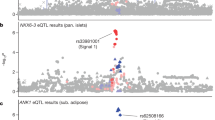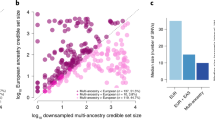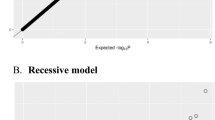Abstract
Type II diabetes mellitus is currently globally one of the fastest growing non-communicable diseases, especially in developing countries. This investigation reports on a meta-analysis undertaken of the C-11377G locus within the adiponectin gene in a black South African, a Cuban Hispanic and a German Caucasian cohort. Genotyping was performed via a real-time PCR strategy. Both fixed- and random-effects models were tested to describe the diabetes risk at both the cohort and population levels. The 2,2 genotype may only be associated with increased diabetes risk in the Cuban Hispanic cohort. Population-specific effects may have masked these associations upon meta-analytical analysis, as no significant odds ratio could be determined. Thus, to examine diabetes risk, a more global approach including the design of population-specific experimental strategies should be used, which will be crucial in developing health education and policies in a global health programme.
This is a preview of subscription content, access via your institution
Access options
Subscribe to this journal
Receive 6 print issues and online access
$259.00 per year
only $43.17 per issue
Buy this article
- Purchase on Springer Link
- Instant access to full article PDF
Prices may be subject to local taxes which are calculated during checkout
Similar content being viewed by others
Abbreviations
- 1,1:
-
homozygous genotype of the wild-type allele
- 1,2:
-
heterozygous genotype
- 2,2:
-
homozygous genotype of the risk allele
- 95% CI:
-
95% confidence interval
- ADIPOQ :
-
adipocyte, C1q and collagen domain containing
- BMI:
-
body mass index
- [-d(F)/d(T) vs T]:
-
negative derivative of the fluorescence level vs temperature
- LC:
-
LightCycler
- n :
-
sample size
- OR:
-
odds ratio
- SNP:
-
single-nucleotide polymorphism
- T2D:
-
type II diabetes mellitus
References
Hanefeld M, Ceriello A, Schwarz PE, Bornstein SR . The metabolic syndrome—a postprandial disease? Horm Metab Res 2006; 38: 435–436.
Schwarz PE, Schwarz J, Bornstein SR, Schulze J . Diabetes prevention—from physiology to implementation. Horm Metab Res 2006; 38: 460–464.
Bornstein SR, Wong ML, Licinio J . 150 years of Sigmund Freud: what would Freud have said about the obesity epidemic? Mol Psychiatry 2006; 11: 1070–1072.
Bornstein SR, Schuppenies A, Wong ML, Licinio J . Approaching the shared biology of obesity and depression: the stress axis as the locus of gene–environment interactions. Mol Psychiatry 2006; 11: 892–902.
Reichel A, Schwarz J, Schulze J, Licinio J, Wong ML, Bornstein SR . Depression and anxiety symptoms in diabetic patients on continuous subcutaneous insulin infusion (CSII). Mol Psychiatry 2005; 10: 975–976.
Tunstall-Pedoe H . Preventing chronic diseases: a vital investment: WHO Global Report. World Health Organization: Geneva, 2005 pp 200 CHF 30.00. ISBN 92 4 1563001. Also published on http://www.who.int/chp/chronic_disease_report/enInt J Epidemiol, 2006.
Schwarz PE, Schwarz J, Schuppenies A, Bornstein SR, Schulze J . Development of a diabetes prevention management program for clinical practice. Public Health Rep 2007; 122: 258–263.
Zimmet P, Alberti KG, Shaw J . Global and societal implications of the diabetes epidemic. Nature 2001; 414: 782–787.
Irizarry K, Hu G, Wong ML, Licinio J, Lee CJ . Single nucleotide polymorphism identification in candidate gene systems of obesity. Pharmacogenomics J 2001; 1: 193–203.
Zimmet P, Shaw J, Alberti KG . Preventing Type 2 diabetes and the dysmetabolic syndrome in the real world: a realistic view. Diabet Med 2003; 20: 693–702.
Halaas JL, Gajiwala KS, Maffei M, Cohen SL, Chait BT, Rabinowitz D et al. Weight-reducing effects of the plasma protein encoded by the obese gene. Science 1995; 269: 543–546.
Hotamisligil GS, Arner P, Caro JF, Atkinson RL, Spiegelman BM . Increased adipose tissue expression of tumor necrosis factor-alpha in human obesity and insulin resistance. J Clin Invest 1995; 95: 2409–2415.
White RT, Damm D, Hancock N, Rosen BS, Lowell BB, Usher P et al. Human adipsin is identical to complement factor D and is expressed at high levels in adipose tissue. J Biol Chem 1992; 267: 9210–9213.
Trayhurn P, Beattie JH . Physiological role of adipose tissue: white adipose tissue as an endocrine and secretory organ. Proc Nutr Soc 2001; 60: 329–339.
Kiessling A, Ehrhart-Bornstein M . Transcription factor 7-like 2 (TCFL2)—a novel factor involved in pathogenesis of type 2 diabetes. Comment on: Grant et al., Nature Genetics 2006, Published online 15 January 2006. Horm Metab Res 2006; 38: 137–138.
Gouni-Berthold I, Giannakidou E, Faust M, Berthold HK, Krone W . The K121Q polymorphism of the plasma cell glycoprotein-1 gene is not associated with diabetes mellitus type 2 in German Caucasians. Horm Metab Res 2006; 38: 524–529.
Fisher E, Li Y, Burwinkel B, Kühr V, Hoffmann K, Möhlig M et al. Preliminary evidence of FABP2 A54T polymorphism associated with reduced risk of type 2 diabetes and obesity in women from a German cohort. Horm Metab Res 2006; 38: 341–345.
Sesti G . Searching for type 2 diabetes genes: prospects in pharmacotherapy. Pharmacogenomics J 2002; 2: 25–29.
Korenblum W, Barthel A, Licinio J, Wong ML, Wolf OT, Kirschbaum C et al. Elevated cortisol levels and increased rates of diabetes and mood symptoms in Soviet Union-born Jewish immigrants to Germany. Mol Psychiatry 2005; 10: 974–975.
Kissebah AH, Sonnenberg GE, Myklebust J, Goldstein M, Broman K, James RG et al. Quantitative trait loci on chromosomes 3 and 17 influence phenotypes of the metabolic syndrome. Proc Natl Acad Sci USA 2000; 97: 14478–14483.
Vionnet N, Hani EH, Dupont S, Gallina S, Francke S, Dotte S et al. Genomewide search for type 2 diabetes-susceptibility genes in French whites: evidence for a novel susceptibility locus for early-onset diabetes on chromosome 3q27-qter and independent replication of a type 2-diabetes locus on chromosome 1q21-q24. Am J Hum Genet 2000; 67: 1470–1480.
Scherer PE, Williams S, Fogliano M, Baldini G, Lodish HF . A novel serum protein similar to C1q, produced exclusively in adipocytes. J Biol Chem 1995; 270: 26746–26749.
Neumeier M, Sigruener A, Eggenhofer E, Weigert J, Weiss TS, Schaeffler A et al. High molecular weight adiponectin reduces apolipoprotein B and E release in human hepatocytes. Biochem Biophys Res Commun 2007; 352: 543–548.
Kumada M, Kihara S, Sumitsuji S, Kawamoto T, Matsumoto S, Ouchi N, et al., Osaka CAD Study Group. Coronary artery disease. Association of hypoadiponectinemia with coronary artery disease in men. Arterioscler Thromb Vasc Biol 2003; 23: 85–89.
Weyer C, Funahashi T, Tanaka S, Hotta K, Matsuzawa Y, Pratley RE et al. Hypoadiponectinemia in obesity and type 2 diabetes: close association with insulin resistance and hyperinsulinemia. J Clin Endocrinol Metab 2001; 86: 1930–1935.
Schwarz PE, Towers GW, Fischer S, Govindarajalu S, Schulze J, Bornstein SR et al. Hypoadiponectinemia is associated with progression toward type 2 diabetes and genetic variation in the ADIPOQ gene promoter. Diabetes Care 2006; 29: 1645–1650.
Thamer C, Haap M, Heller E, Joel L, Braun S, Tschritter O et al. Beta cell function, insulin resistance and plasma adiponectin concentrations are predictors for the change of postprandial glucose in non-diabetic subjects at risk for type 2 diabetes. Horm Metab Res 2006; 38: 178–182.
Yamauchi T, Kamon J, Waki H, Terauchi Y, Kubota N, Hara K et al. The fat-derived hormone adiponectin reverses insulin resistance associated with both lipoatrophy and obesity. Nat Med 2001; 7: 941–946.
Ravussin E . Adiponectin enhances insulin action by decreasing ectopic fat deposition. Pharmacogenomics J 2002; 2: 4–7.
Schutte AE, O'Dea K, Schwarz PE . Could statistical adjustments for age mask the insulin-blood pressure relationship? Diabetes Res Clin Pract 2006; 72: 104–107.
Kazumi T, Kawaguchi A, Hirano T, Yoshino G . Serum alanine aminotransferase is associated with serum adiponectin, C-reactive protein and apolipoprotein B in young healthy men. Horm Metab Res 2006; 38: 119–124.
Heliovaara MK, Strandberg TE, Karonen SL, Ebeling P . Association of serum adiponectin concentration to lipid and glucose metabolism in healthy humans. Horm Metab Res 2006; 38: 336–340.
Garcia AL, Steiniger J, Reich SC, Weickert MO, Harsch I, Machowetz A et al. Arabinoxylan fibre consumption improved glucose metabolism, but did not affect serum adipokines in subjects with impaired glucose tolerance. Horm Metab Res 2006; 38: 761–766.
Vasseur F, Helbecque N, Dina C, Lobbens S, Delannoy V, Gaget S et al. Single-nucleotide polymorphism haplotypes in the both proximal promoter and exon 3 of the APM1 gene modulate adipocyte-secreted adiponectin hormone levels and contribute to the genetic risk for type 2 diabetes in French Caucasians. Hum Mol Genet 2002; 11: 2607–2614.
Stumvoll M, Tschritter O, Fritsche A, Staiger H, Renn W, Weisser M et al. Association of the T-G polymorphism in adiponectin (exon 2) with obesity and insulin sensitivity: interaction with family history of type 2 diabetes. Diabetes 2002; 51: 37–41.
Kondo H, Shimomura I, Matsukawa Y, Kumada M, Takahashi M, Matsuda M et al. Association of adiponectin mutation with type 2 diabetes: a candidate gene for the insulin resistance syndrome. Diabetes 2002; 51: 2325–2328.
Brown MD, Starikovskaya E, Derbeneva O, Hosseini S, Allen JC, Mikhailovskaya IE et al. The role of mtDNA background in disease expression: a new primary LHON mutation associated with Western Eurasian haplogroup J. Hum Genet 2002; 110: 130–138.
Mishmar D, Ruiz-Pesini E, Golik P, Macaulay V, Clark AG, Hosseini S et al. Natural selection shaped regional mtDNA variation in humans. Proc Natl Acad Sci USA 2003; 100: 171–176.
Reimann M, Schutte AE, Huisman HW, Schutte R, Van Rooyen JM, Malan L et al. Differences in C-peptide and non-esterified fatty acid function between African and Caucasian women from South Africa. J Hypertens 2006; 24: 237.
Barnett AH, Eff C, Leslie RD, Pyke DA . Diabetes in identical twins: a study of 200 pairs. Diabetologia 1981; 20: 87–93.
Bergman RN, Phillips LS, Cobelli C . Physiologic evaluation of factors controlling glucose tolerance in man: measurement of insulin sensitivity and beta-cell glucose sensitivity from the response to intravenous glucose. J Clin Invest 1981; 68: 1456–1467.
King H, Aubert RE, Herman WH . Global burden of diabetes, 1995–2025: prevalence, numerical estimates, and projections. Diabetes Care 1998; 21: 1414–1431.
Omar MA, Seedat MA, Motala AA, Dyer RB, Becker P . The prevalence of diabetes mellitus and impaired glucose tolerance in a group of urban South African blacks. S Afr Med J 1993; 83: 641–643.
Schwarz PE, Govindarajalu S, Towers W, Schwanebeck U, Fischer S, Vasseur F et al. Haplotypes in the promoter region of the ADIPOQ gene are associated with increased diabetes risk in a German Caucasian population. Horm Metab Res 2006; 38: 447–451.
Olckers A, Towers GW, van der Merwe A, Schwarz PE, Rheeder P, Schutte AE . Protective effect against type 2 diabetes mellitus identified within the ACDC gene in a black South African diabetic cohort. Metabolism 2007; 56: 587–592.
Schutte AE, Huisman HW, Schutte R, van Rooyen JM, Malan L, Malan NT . Aging influences the level and functions of fasting plasma ghrelin levels: the POWIRS-Study. Regul Pept 2007; 139: 65–71.
Flint J, Harding RM, Clegg JB, Boyce AJ . Why are some genetic diseases common? Distinguishing selection from other processes by molecular analysis of globin gene variants. Hum Genet 1993; 91: 91–117.
Ingelman-Sundberg M . Genetic polymorphisms of cytochrome P450 2D6 (CYP2D6): clinical consequences, evolutionary aspects and functional diversity. Pharmacogenomics J 2005; 5: 6–13.
Schwarz PEH, Towers GW, Fischer S, Schulze J, Hanefeld M, Bornstein SR et al. APM1 gene Haplotypes are linked to a pre-existing hypoadiponectinaemia and through this to the progression toward type 2 diabetes. Diabetes 2005; 54: A283.
Alberti KG, Zimmet PZ . Definition, diagnosis and classification of diabetes mellitus and its complications. Part 1: diagnosis and classification of diabetes mellitus provisional report of a WHO consultation. Diabet Med 1998; 15: 539–553.
Bland JM, Altman DG . The odds ratio. BMJ 2000; 320: 1468.
Mantel N, Haenszel W . Statistical aspects of the analysis of data from retrospective studies of disease. J Natl Cancer Inst 1959; 22: 719–748.
DerSimonian R, Laird N . Meta-analysis in clinical trials. Control Clin Trials 1986; 7: 177–188.
Review Manager. Review Manager (RevMan) (Computer Program) 2002. The Cochrane Collaboration: Oxford, England.
Acknowledgements
We thank the following individuals and institutions: individuals who participated in this study and their referring physicians. M Alessandrini, T Semete, T van Brummelen, M Wessels, U Buro, J Braun and A von Loeffelholz for assistance. Collaborators of the Profiles of Obese Women with Insulin Resistance Syndrome study of 2003 (POWIRS1) at North-West University (Potchefstroom Campus). The POWIRS1 study was funded by Strategic Fund award from the North-West University (Potchefstroom Campus) to AO, and grants from DNAbiotec (Pty) Ltd, Medical Research Council (MRC) of South Africa and National Research Foundation (NRF) (GUN 2054068) of South Africa to AES. The ADIPOQ in Africans study was funded by DNAbiotec (Pty) Ltd and a funding grant (MeDDrive) from the Dresden University of Technology to PEHS.
Author information
Authors and Affiliations
Corresponding author
Additional information
Duality of interest
None declared.
Rights and permissions
About this article
Cite this article
Schwarz, P., Towers, G., van der Merwe, A. et al. Global meta-analysis of the C-11377G alteration in the ADIPOQ gene indicates the presence of population-specific effects: challenge for global health initiatives. Pharmacogenomics J 9, 42–48 (2009). https://doi.org/10.1038/tpj.2008.2
Received:
Accepted:
Published:
Issue Date:
DOI: https://doi.org/10.1038/tpj.2008.2
Keywords
This article is cited by
-
Burden of disease attributable to suboptimal diet, metabolic risks and low physical activity in Ethiopia and comparison with Eastern sub-Saharan African countries, 1990–2015: findings from the Global Burden of Disease Study 2015
BMC Public Health (2018)
-
A Validation Study of Adiponectin rs266729 Gene Variant with Type 2 Diabetes, Obesity, and Metabolic Phenotypes in a Taiwanese Population
Biochemical Genetics (2016)



